Alight with White: Native Flowering Trees to Brighten Spring Days
April 14, 2012 by admin
Filed under Native Plants, Spring Bloomers
It’s spring in southern New England! With deciduous trees still bare and most of the understory just waking up, the landscape remains largely brown and grey. But in a few short weeks, wherever there are trees, there’ll be shade. White flowers show up beautifully against both backgrounds, which may explain why so many of our native trees and shrubs have them.
We all know and love the flowering dogwood that’s so emblematic of our eastern woodlands, but in this post I’d like to sing the praises of two lesser known trees with white flowers that can make equally admirable additions to the landscape.
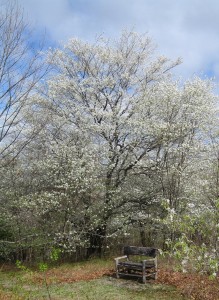
A tree-form shad in its April glory.
The shads (also called shadbush, shadblow, juneberry or serviceberry) are a rather taxonomically confused group of trees and shrubs, but don’t let that put you off. All shads are members of the genus Amelanchier. A. arborea is the largest, a tree that can rival a star magnolia in size and shape if given enough sun and good soil. A. canadensis and A. laevis are both smaller, more willowy, and usually multi-trunked. There are also hybrid crosses between these species, as well as shrubs forms native to both the East and West Coasts (A. stolonifera and A. lamarckii, respectively).
The tree forms are grown more as ornamental landscape plants, while the shrub forms are grown either for fruit or for naturalizing, since they tend to sucker. All of them have delicate flowers, borne when the plants are still leafless, that look like a bunch of short white streamers flying in the wind. In early summer they produce fruits the size and color of wild blueberries. These come and go in the blink of an eye because they are a favorite bird food, so bird lovers take note.
They are said to make great people food, too, but I’ve never cultivated them for their fruit and I suspect that humans who try might need to fence them to keep the birds from making off with everything.
To top things off, shads also offer good fall foliage, with yellows and oranges predominating.
In practice, shads for sale in nurseries aren’t always labeled with tremendous accuracy, so don’t rely too heavily on that. You just want to make sure you’ve bought a tree form if you want a tree, and a shrub form if you want a shrub. Plant all of them at the woodland edge just as you would a dogwood, and they’ll light up grey April days.

The unusual tassel-like flowers of fringe tree.
Chionanthus leafs out significantly later than most other woody plants, which has made more than one client call me in mid May to say, “I think we lost the fringe tree this winter,” but I have yet to see one die in the landscape if planted well. Buy the plant in flower if you can; plants are either male or female, and males have showier blossoms.
Both shad and fringe tree will do fine planted in loamy soil with average moisture and good drainage, although both can tolerate less than this ideal. Shads can be grown from the Canadian border and even points further north down through the Carolinas and into parts of Georgia. Fringe tree is cold hardy at least to Zone 5, but supposedly occurs naturally as far south as the Gulf of Mexico.
Lucky for me, they both do well in southern New England, where I love them as low care woodies that seem to capture and hold light in the garden in their season.
Do You Want to Know a Secret?
March 3, 2010 by admin
Filed under Bulbs, Spring Bloomers
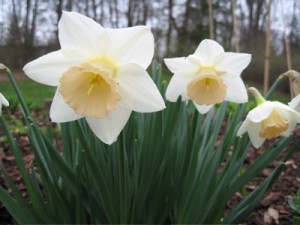
In an impossibly few short weeks, we’ll all be seeing a lot of these: daffodils. That’s why I thought it would be a good time of year to let you in on a little secret. I’m not talking about garden intrigue; this isn’t the kind of secret anyone keeps intentionally. It’s just a little fact about daffodils (and other spring-blooming bulbs) that even experienced gardeners often don’t know.
But let me start at the beginning. A lot of people ask me about growing daffodils because deer and other animals don’t browse them. Unlike tulips, which are a favorite food of both deer and a number of rodents, daffodils produce chemicals that are highly toxic, and animals instinctively avoid eating them.
Daffodils are extremely easy to grow as long as their basic needs are met, and their number one need is sun—at least six hours a day of it for large-flowered daffodils like the one pictured above.
The biggest mistake I see people making with daffodils is placing them in too much shade. One reason people get confused about how much shade daffodils (or any other bulb) can take is because the first year after planting, they always bloom beautifully, even if planted in significant shade. That leads people to think they’ll continue to bloom in shade year after year. Unfortunately, except for a few small species daffodils that are far less demanding than the large-flowered types most people want to grow, they won’t.
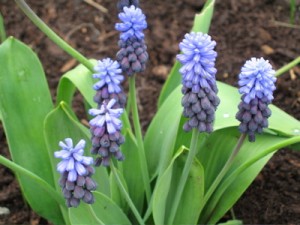
Grape hyacinth (this one is Muscari latifolium) is another spring bulb that does best with plenty of sun.
Just about all spring bulbs (there might be an exception or two, but I can’t think of one) produce their flower buds the year before they open. That means that the buds for the daffodils that will bloom in a few weeks formed last spring and summer. As soon as the daffodils finish blooming this year, they’ll start producing the buds that will open next year. You won’t see those buds, however, because they’ll be hidden down in the bulb and they’ll remain there until next spring.
So, when daffodils are planted in shade and bloom well the next spring, that’s because the buds to produce those flowers were developed and ready to burst into bloom before they were planted. (And I guarantee that the bulb grower raised them in lots of sun!) However, once planted in shade, those daffodils won’t be able to produce as many flower buds for the following year because there’s not enough light available to them. Over the course of three or four years, they’ll produce fewer and fewer buds until they do nothing but put up leaves and an occasional flower. So, if you have daffodils that do that, it’s because they’re growing in too much shade, and the only way to get them to flower well again is to move them to a sunnier spot. Fertilizer will not help with this problem because the problem isn’t a lack of nutrients—it’s a lack of light.
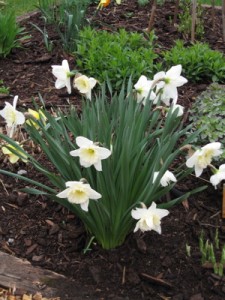
A clump of Narcissus ‘Ice Follies’ blooms well again after several years of “sun therapy.”
After a few years growing in more sun, daffodils will recover and start flowering again. Actually, the daffodils in the picture at left were moved from a spot too shady for them about four years before the picture was taken, and you can see how well they bounced back.
If you remember, I said that large-flowered daffodils need full sun. Species daffodils are more shade tolerant. Being so much smaller, they don’t need as much solar energy to produce flower buds for next year, but they’re still not shade loving plants. Give all daffodils as much sun as you can, and use bulbs such as Siberian squill (Scilla siberica), snowdrops (Galanthus spp.) and crocus (Crocus) where light levels are low. These plants are much better adapted to shade.
So, the secret is out. Remember that a spring bulb won’t show the effects of a deficit of sun (or nutrients, for that matter) until the year after the problem occurs. Given what they need, all hardy bulbs have the potential to return and beautify your landscape for many years to come.
Breathtaking Bluebells
April 3, 2009 by admin
Filed under Shade Gardening, Spring Bloomers, Spring Ephemerals
Virginia bluebells (Mertensia virginica) are nothing less than the royalty of spring ephemerals. Large, showy, and colorful, they put on one of the very best spectacles of any spring blooming plant, with all the rich costuming you’d expect in the court of a queen.
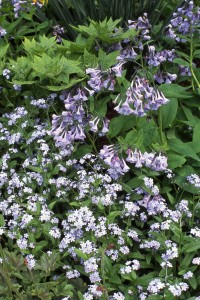
A May mêlée of Virginia bluebells and forget-me-nots
Virginia bluebells break ground very early in spring. Their tightly furled leaves look like tiny burgundy cabbages when they first emerge, but as they grow they quickly morph into medium green, fleshy oblongs that resemble the leafy green vegetable sorrel. Seemingly in no time they produce profuse clusters of dangling blue bell-shaped flowers on 18″ stems, blooming for several weeks in May. (They also come in a white-flowered form that is uncommon but possible to find.) Once flowering ceases, and almost before you have time to notice, they close up shop. Their leaves yellow rapidly, and the plants have gone completely dormant by mid June. They’ll spend the remainder of the year as inscrutable, seemingly dead but really just dormant roots nestled just below the soil surface. Incredibly, their entire aboveground life cycle is barely two months long.
The sheer rapidity of their growth and “demise” along with their large size and showiness make Virginia bluebells very border friendly. Their leaves do not need to hang around the garden for months to store enough energy to ensure flowering the following year. They put on their spectacular display and then vanish—a gardener’s dream!
Virginia bluebells are excellent interplanted with other blue-flowering plants such as perennial woodland phlox (Phlox divaricata). This phlox flowers just as the bluebells fade, so the segue from one to the other is seamless, and because the phlox spreads into a non-competitive groundcover, the bluebells will continue to arise through the mat of phlox foliage year after year. Biennial forget-me-not (Myosotis sylvatica) also makes a great companion, as shown in the photo above.
Virginia bluebells’ sky blue flowers are also an effective counterpoint to yellow daffodils. Gardeners with borders in both sun and shade can take best advantage of this artful duo, planting the sunny areas with clumps of daffodils and the shady ones with masses of bluebells. The result will be breathtaking!
Another natural companion is old-fashioned bleeding heart, whose brilliant pink or clean white flowers reach their peak simultaneously with those of Virginia bluebells, although the latter plant will go dormant months before the former. If you try this combination, use hostas, ferns or other late-emerging plants to fill in the areas occupied by the bluebells in May.
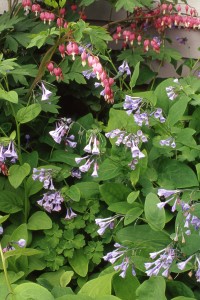
Bluebells and bleeding heart make a natural garden combination
Virginia bluebells spread readily by seed, moving outward from an original planting at a speed of a foot or two a year. In autumn, be careful working in the parts of your garden where bluebells are established, since it is so easy to dig into and accidentally destroy dormant roots at that time of year.
It’s not too late to have Virginia bluebells this year. Nurseries often stock them in April and early May since they’re one of the few plants that can be sold in full bloom at such a chilly time of year.
Sun/Shade needs: Half sun to moderately deep shade; full sun with adequate moisture
Hardiness: Zone 3
Size: 12-18″ tall; 8″ wide
Native status: Native to most of eastern North America, but not all of New England
Bloom times and other life cycle stats are accurate for northwest Connecticut. In milder areas all aspects of a plant’s life cycle may occur earlier in the year, and in colder areas, later.
March, 2010: Update! The good folks at GardenSMART took a shine to this article and reprinted it at their website. You’ll find this post (and many other interesting items) in the Articles section.
Signs of Spring
March 25, 2009 by admin
Filed under Shade Gardening, Spring, Spring Bloomers, Techniques
At 7:44 AM on March 20 the Sun crossed the celestial equator heading north. In common parlance, that translates to: spring is here!
It didn’t take long for wildlife to answer the call. Two days later, I awoke to the sound of a red-breasted robin singing at 6:00 AM. The cardinals have been getting redder and redder and going great gangbusters for weeks with their impressions of distant car alarms, but they’re here year round. The robin was the first migrant I’d heard stretch its vocal cords this year.
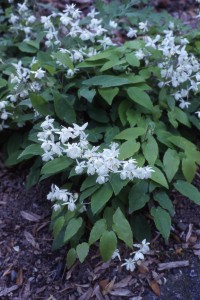
Epimedium x youngianum 'Niveum' in its April glory
While the robins celebrated spring by completing the last leg of their long journey, I was out in the garden performing one of the first jobs necessary to the season: uncovering my epimediums. (They have a common name—bishop’s hat—but somehow I just can’t bring myself to use it. They’ll always be epimediums to me.)
Along with hellebores and lungworts, epimediums start growing actively in March long before many of us have gotten out to remove the leaves that blew into the garden late last year after the rake had been put away for its long winter’s nap. (Or was it the gardener determined to nap? Tools can be convenient excuses…)
If you live on a lot with many trees, no matter how much you raked and blew last fall, you might find a lot of leaves staring up at you from the garden when the snow melts. Many plants can benefit from that cozy little coverlet, but for others it’s a problem.
While hellebores and lungworts are sturdy plants that can withstand the inevitable manhandling that occurs when you peel away sopping wet mats of oak leaves, epimediums are delicate little things with fragile stems all too easily snapped off. Wait even a week too long to clear them of leaf litter, and you may not be able to do it without surgical tools. (I exaggerate, but not by much.)
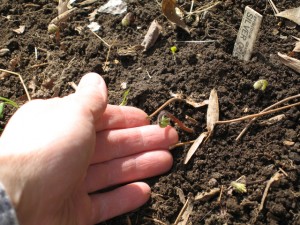
New epimedium growth under the leaf litter in March
At left is a picture of a curled epimedium flower stalk taken on March 20 just after being uncovered. This happens to be a patch of E. ‘Silver Queen’, a large-flowered white variety. In just a few weeks, it will put on a display to rival the extravagant bloomer E. x youngianum ‘Niveum’ shown in the picture above.
As careful as I tried to be when I removed the errant leaves, I wasn’t careful enough. Below left is a photograph of a stalk that I clumsily damaged. It takes almost no force to snap the top off these little guys, and that’s one spray of flowers less for me, the bees and everyone else this spring.
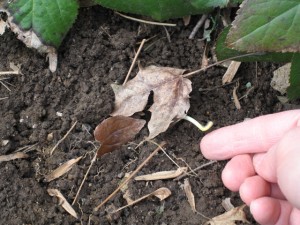
Epimedium stalk accidentally broken off
Some epimediums have fairly persistent stalks that don’t disintegrate on their own over winter. While you might not have to groom ‘Niveum’ at all, most others aren’t as accommodating. E. x perralchicum ‘Frohnleiten’ has perhaps the most evergreen leaves of any epimedium. This is both a plus and a minus. In snowless winters, they’re something to look at. But snow or no snow, in spring they’ll require cleanup. A pair of hedge clippers is the tool for this task. They do the job quickly and with all the precision required. You could just leave last year’s foliage alone, and new growth would come up through it and eventually conceal it, but most epimediums look better with a figurative shower and shave.
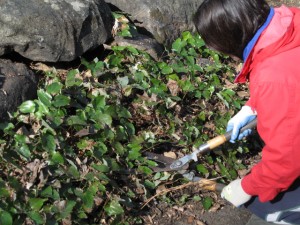
Shearing back epimediums in mid March
Unless you mulched last autumn, have some light, compost-based mulch handy to spread on your epimediums as soon as you uncover them. Otherwise, the soil around them will dry out quickly. At this time of year the sun is surprisingly intense, although most of us aren’t aware of it because air temperatures haven’t climbed yet. But I’ve learned that when I come out of my winter semi-hibernation and start working outdoors up to eight hours a day in March and April, I’d better wear sunscreen! New growth of shade-loving plants should also have some protection, not from the sun itself, but from the soil dryness it can cause.
Of course, even if I didn’t remove the leaves from my epimediums, they’d grow right up through their brown blanket and bloom anyway. But I prefer the look of a clean bed with a dressing of compost as a nice backdrop. Knowing that the job of removing those leaves without damaging the epimediums becomes harder with each passing day is enough incentive for me to get outside in mid March no matter what the weather. Ironically, as intolerant as they are of mishandling, fresh new epimedium growth will have no problem withstanding freezing nights.
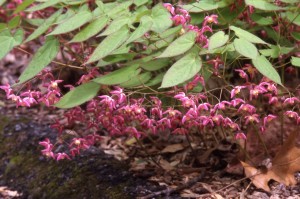
The reason for the work of the season. Darn—where'd that leaf come from?!
Spring Blooming Shade Plants: Hellebores
March 18, 2009 by admin
Filed under Perennials, Shade Gardening, Spring Bloomers
In a typical year, hellebores will be the first ornamental perennial to bloom in the Northeast. Although there are several species that can be grown in this region, especially in milder areas such as the coast and the lower Connecticut River Valley, one of the hardiest remains my favorite: Helleborus x hybridus (formerly and sometimes still known as Helleborus x orientalis).
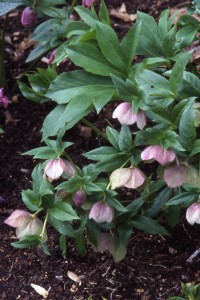
Helleborus x hybridus
Here in northwest Connecticut, hellebores send up their flower buds first, in March, before their leaves unfurl. As the month goes on, these succulent and tender looking shoots grow taller and taller, until they finally open up around April 1 to reveal clusters of 2″-wide, pendant blossoms. The species H. x hybridus is quite variable, with a range of subtle flower colors including creamy white, apple green, pale pink and burgundy. Its flowers often have striking speckled markings and prominent yellow anthers that are showy for about a week until the stamens fall off.
At first, hellebore flowers look a bit undressed because the plant’s leaves don’t come along until a few weeks later. When they do make their appearance, however, they are exceptionally attractive—leathery, glossy, palmate (arranged like fingers around the palm of a hand) and semi-evergreen.
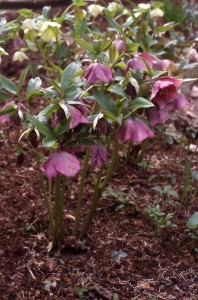
Hellebore flowers emerge before leaves
Everything about hellebores is long lasting. Instead of dropping off after 2-3 weeks, hellebore flowers slowly fade to a pale green or buff color in much the same way hydrangea flowers do. They look good (although subdued) right up to the point when the seeds mature and are dispersed, usually in the latter half of June. Deadhead them before that point unless you want seedlings the following spring. In most gardens, the leaves will remain disease free and unblemished all season long, and will still be looking good when the first snow flies.
Shade tolerance: High
Hardiness: Zone 5; other species may differ
Size: Medium sized, with a height and spread of 15-18″
Native status: non-native to any part of North America
Growing Tips
- Don’t cut back hellebore foliage in fall, even if you clean up the rest of your garden then. Why? Hellebores come up so early in the year, they are subject to damage from late frosts. These frosts won’t kill the plants, but they will kill the flower buds. As the plant’s shoots begin to emerge from the ground, last year’s leaves will provide some protection. After the new shoots have grown taller than last year’s leaves, you can groom them, cutting off the old foliage at ground level. Be careful not to accidentally cut off new growth—it’s easy to do. For a few more weeks after you groom them, it’s a good idea to keep some pine boughs or an equivalent handy to gently arrange over the new growth at night if a hard frost is in the forecast.
- Hellebores have to be several years old before they are mature enough to flower. A nursery plant in a 5-pint pot is probably only two years old, so don’t be surprised if it doesn’t flower its first (or even second) year in the ground. As long as the plant grows well and looks healthy, flowering should start when the plant is ready. A plant that fills a one-gallon pot should be old enough to flower its first spring after planting.
- H. x hybridus is often sold in a mix of undifferentiated colors. In other words, if the tag in the pot with your plant does not specify a flower color, but just says H. x hybridus, it could be any of the flower colors listed above. There’s no way to know which color you’ve got unless you buy the plant in bloom very early in the season and the plant is old enough to be blooming in the first place. In recent years, some growers have also offered hellebores in designated colors. I like the way the mixed colors look in the garden when hellebores are massed, but gardeners with color-theme gardens might prefer to purchase all of one kind.
- Hellebores have no special needs, but they don’t like excessive moisture. If put in exceedingly dank locations or planted in soils that drain poorly, rot of the crown may result.
- Hellebores self-sow moderately. Their seeds are large and heavy, so they don’t usually travel very far. If you don’t deadhead your plants before they drop their seeds, you’ll probably find a “skirt” of seedlings around their feet in spring. Move these to a nursery bed to mature or give them away to friends.
Bloom times and other life cycle stats are accurate for northwest Connecticut. In milder areas all aspects of a plant’s life cycle may occur earlier in the year, and in colder areas, later.

